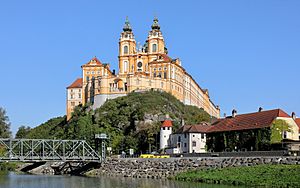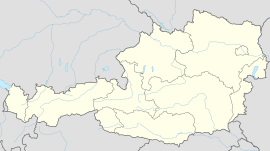Melk facts for kids
Quick facts for kids
Melk
|
||
|---|---|---|

|
||
|
||
| Country | Austria | |
| State | Lower Austria | |
| District | Melk | |
| Area | ||
| • Total | 25.7 km2 (9.9 sq mi) | |
| Elevation | 213 m (699 ft) | |
| Population
(2018-01-01)
|
||
| • Total | 5,529 | |
| • Density | 215.1/km2 (557.2/sq mi) | |
| Time zone | UTC+1 (CET) | |
| • Summer (DST) | UTC+2 (CEST) | |
| Postal code |
3390
|
|
| Area code | 0 27 52 | |
| Vehicle registration | ME | |
Melk is a city in Lower Austria, a state in Austria. It sits right next to the beautiful Wachau valley, along the famous Danube River. About 5,500 people live in Melk.
Melk is most famous for its huge and stunning baroque Benedictine monastery, called Melk Abbey. This impressive building is a major landmark.
The town was first mentioned in a document in 831. It was called Medilica, which means 'border' in an old Slavic language. The area around Melk was given to Leopold I, Margrave of Austria in 976. This was to create a safe zone between the Magyars to the east and Bavaria to the west.
In 996, the name Ostarrîchi was first used for this area. This is where the German word Österreich (Austria) comes from. The tall cliff where the monastery now stands used to have a castle. In 1089, Leopold II, Margrave of Austria gave this site to Benedictine monks.
Melk became a market town in 1227. It officially became a municipality (a self-governing town) in 1898. Melk is special because it has many different types of buildings from various centuries, all in a small area.
Contents |
Exploring Melk's Historic Sights
Let's take a tour of the interesting places in Melk.
The Forsthaus and Old City Gates
The Forsthaus building is where the city's old records are kept. It also has the tourist information office. This is a good place to start your visit. Next to it, you'll see parts of the old city wall.
Until 1874, there was a gate here called the Wiener Tor (Vienna Gate). It was one of two main entrances to Melk for hundreds of years. The other gate, the Linzer Tor (Linz Gate), was on the other side of the city. Neither gate exists today, but you can see old pictures of them in the city archives.
Rathausplatz and Its Buildings
A short walk leads to the Rathausplatz, a lovely square. It's named after the Rathaus (City Hall), which was built in 1575. The City Hall's front was updated about 150 years ago. Its most striking feature is a beautiful entrance door made of wood and copper.
To the left of the City Hall is the old Lebzelterhaus, built in 1657. Today, it's a pharmacy. On the right, you'll see a very old building from the Middle Ages. In the middle of the square is the Kolomanbrunnen, a market fountain. It was a gift from the abbey to the city. At the top of the fountain, there's a statue of Saint Koloman.
Ancient Lanes and Hidden Gems
The old bread store is about 400 years old. It still has its original shingle roof and tiny towers. Behind it is the Sterngasse, the oldest lane in Melk. This used to be the main street. The interesting paintings on the houses here show what they used to be. Some houses also have charming courtyards.
The 'Haus am Stein' (house at the rock) is Melk's oldest building, built in the 1400s. An old vine covers its front. Near the Danube River, you can still see parts of the old city walls and the Round Tower.
River Views and Historical Markers
As you follow the Nibelungenlände, you'll pass the Salzhof. Then you reach the Schiffsmeisterhaus. This building has marks on its front showing how high the water reached during big floods. In 1501, the Danube River rose 15.8 meters (about 52 feet) above its normal level!
The 'Haus auf dem Stein' (house on the rock) was built less than 50 years after that huge flood. An Austrian painter named Walter Prinzl used it as his art studio.
Defensive Structures and Important Buildings
At the corner of the Stadtgraben (which means moat), there's a defensive tower. Parts of this tower are still in their original condition.
The Old Post Office is at the end of the moat. It was built in 1792. Its front has a beautiful relief (a type of sculpture) from the end of the Baroque period. Today, the Old Post Office is used as a place for meetings and events.
The church court is dominated by the Gothic Pfarrkirche (parish church). It was designed in the late Gothic style. On its northern side, there's a significant sculpture called the Kalvarienberggruppe. Before the main road connects to the Rathausplatz, a special plaque remembers the great Austrian composer Anton Bruckner.
Nearby Attractions
About 5 kilometers (3 miles) south of Melk is the famous Renaissance castle Schallaburg. It's known for its beautiful design.
Melk in History
During World War II, a smaller camp of the Mauthausen concentration camp was located here. Today, the former crematorium (a building for burning bodies) is a museum. The rest of the camp is now part of the Birago barracks, used by the Austrian Army.
In 1950, Melk hosted the first official women's Austrian Chess Championship. The winner was Salome Reischer.
Melk in Fiction
In the famous book The Name of the Rose by Umberto Eco, one of the main characters is Adso of Melk. He is a young Benedictine monk traveling in 1327.
Notable People from Melk
- Gertrude of Babenberg, Duchess of Bohemia
- Ingomar Grünauer (born 1938), a composer
- Maximilian Stadler
See also
 In Spanish: Melk para niños
In Spanish: Melk para niños



